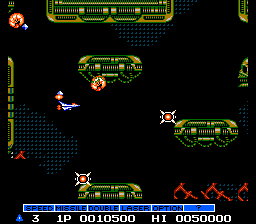

There's a part of me that feels kind of ripped off by that decision. When deciding which title to localize, Konami gave the nod to the one that alternated between horizontal and vertically scrolling stages, instead of one which was simply a great sequel to a well-known game. I can’t be sure, of course, but that’s another factor that may have prevented both games from reaching the United States back in 1988. A lot of the new content in the home conversion of Gradius II actually came straight from Life Force. Since the Famicom didn't have the same processing ability as the average arcade board, Konami changed a few levels and inserted new elements to make sure the port was worth playing. Konami had the interesting habit of somewhat altering games when porting them from the arcade to home systems. That likely explains why we didn't get Gradius II. Around the time this one might have come out in the region, we instead saw Konami's port of Salamander (known here as Life Force). Not only is it a really good shooter that dramatically improves upon its predecessor, but it also wasn't originally released in America. The Famicom's Gradius II is an interesting title. If the particular path you're charting through the asteroids seems too fraught with danger, it's simplicity itself to go over one instead of under it in order to fight a different arrangement of foes." Making this level particularly neat is the way you can scroll up and down while moving to the right.

The reuse of this sprite from Life Force cosmetically alters the Vic Viper from a single thruster engine to a pair of engines. Player 1 uses Vic Viper's coloration of a blue ship with red options, while Player 2 uses the Lord British coloration red with blue options. Similar to Life Force, each player is represented by slightly different colors.After completing the final stage and returning to the first stage, the difficulty increases, but it will not increase again on subsequent completions.Bosses can never be defeated by waiting long enough until they self-destruct.The hit box which surrounds the Vic Viper is a bit larger in this version, making it more vulnerable to attacks.The Option Hunter does not appear in this version.This feature imitates the time limited Rotating Barrier power-up which originated in Gradius 2 for the MSX. For a limited period of time, all four Options will rotate around the Vic Viper before returning to the traditional snake-follow pattern, at which time Option will reappear on the power meter and can be activated again. After you have activated four Options, you may choose the Option command again to activate the Option Rotation behavior.As a result, it is capable of sustaining five hits before depleting, as opposed to three in the arcade version. You can no longer choose between the Shields and the Force Field.Both the Laser and the Ripple can be selected twice, once to activate it, and a second time to improve its effectiveness. Both Laser abilities produce the Cyclone Laser effect, which is generated by rapidly drawing different chunks of the laser on every frame.Rather, a small circle indicated the position of the bomb, and the explosion it produces is much more effective at eliminating enemies than in the arcade game. The Spread Bomb ability does not actually produce missiles like the other Missile abilities do.The vocalization of Gofer is also accomplished through combinations of these words.

They are simplified and the same for all four power type arrangements, but they are present. It is also the only Famicom conversion of a Gradius game to feature the vocal announcements of activated power-ups.( Gradius allowed two, and the Japanese version of Life Force allowed for three Options, shared between both players.) It is noteworthy that as the last Famicom conversion in the series, Gradius II finally allows players to activate four Options just like in the arcade.


 0 kommentar(er)
0 kommentar(er)
